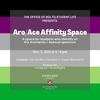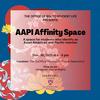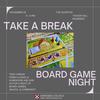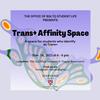This post first appeared on the Harvard Sexual Literacy Project column on November 16, 2017.
Sheehan D. Scarborough, Director of the Office of BGLTQ Student Life ("SDS"): This is the final week of our three-part guest post on sexual assault and intimate partner violence in the queer community. And one last time, we’re going to light our candle as we hold this topic with the care and compassion it deserves. So far in this series, we’ve talked about various experiences of harm within the context of queer community, as well as factors that can impact a person’s access to resources. But today we want to talk about the role of the community in responding to harm, sexual assault or intimate partner violence. We’ll offer some steps that we as community members can take both to prevent harm and to make our community safer for those who have experienced harm.
Undergraduate Intern in the Office of BGLTQ Student Life ("BJG"): Community itself is such a precious resource. Community takes on many forms and can provide so much to an individual: affinity, support, connection, fellowship, and even the possibility of discovering companionship. As we mentioned in our first post, for a small community, it’s quite possible that you would come to know many other members by face at least, if not also by name. A small community is “where everybody knows your name.” This is true not just for the BGLTQ community, but many others on campus, such as religious groups, cultural affinity groups, and shared-interest groups.
SDS: Cheers for that great description, BJG. Experiences of harm can jeopardize access to community, as we’ve touched on before. Think of all of the places where the queer community gathers on campus. It can be harder to avoid a person if they’re at the same dances, community mixers, in the same student groups, or attending the same kinds of courses (take ‘Women, Gender, and Sexuality’ classes, for example). “Will the person who harmed me be at the next party?” “Will I have to see them at club meetings?”
BJG: Other members of the community may be drawn into this experience as well. For example, hearing about another person’s experience of harm can bring up painful memories for someone who has had a similar experience in the past. Likewise, someone who has experienced harm, or someone who has caused harm, may reach out to a friend to process that, and to figure out what to do next.
SDS: That raises another issue. When everybody knows your name, it can feel like everybody knows your business, too. Unfortunately, when harm occurs between members of the same community, that information can travel quickly. The community can begin to feel quite small, and privacy can be hard to come by. It can be really difficult when community members take sides; whether or not they were there, and whether or not they were privy to what took place, people can form opinions.
BJG: Speaking of opinions, there may also be concern about how this all affects perceptions of the queer community. There is a sad history of homophobia and transphobia that has led our community to be portrayed in a negative light. Addressing sexual assault and intimate partner violence as a problem could feel like pathologizing the community, feeding into the narrative there is some particular vice or sickness at the heart of the community. Even for the two of us, naming all of these very real issues that people experience within the queer community feels a bit like airing our dirty laundry, or unearthing something that is better buried. But there’s a pernicious way that this harm gets perpetuated, and normalized, when we don’t encourage ourselves and our communities to reflect and talk frankly about what we can and should be doing better as a community. In many ways, silence hasn’t helped us.
SDS: Sometimes, the only way to root out these problems is to address them directly, as difficult or uncomfortable as that may be. We as a community should be thinking about these issues all the time. And that goes for members of any community, big or small. Before anyone names harm, we should already have created space to support them. It shouldn’t feel like someone naming harm is “rupturing” the community, because there should already be an open and consistent dialogue on harm. This is something that every community should aspire to.
BJG: Community also has a role to play in healing and prevention. This can take the form of willingness to intercede when you notice controlling or predatory behavior, or indications of harm. It can mean checking in on friends and others around you in social settings, particularly when alcohol is involved. It can mean respecting people’s privacy, and not spreading information or rumors as gossip. And because you never know if, or when, someone will reach out to you for help, it can mean being familiar with the resources that exist on campus to support those who have experienced sexual assault, intimate partner violence, and other forms of harm. These are all expectations that community members can set for one another.
SDS: Ultimately, that requires people to reflect seriously on the question, How do we want to treat people in our community? And how does that reflect our history and our values? We think about this a lot in the Office of BGLTQ Student Life, and we’re so glad for the opportunity to share these reflections on queer community, resources, and access over the past three weeks. We hope it’s encouraged you to think about your role in helping to minimize the barriers to accessing resources, and creating communities where people feel safe and take responsibility for one another. Finally, we invite you to hold onto this flame, and be a light for someone around you. Come stop by our office at 7 Linden St, or visit us at our new location in Grays Hall starting in January. See you around campus!
Signatures:
Sheehan Scarborough, Director of the Office of BGLTQ Student Life
BJG, Undergraduate Intern ("Quintern") in the Office of BGLTQ Student Life





